Here are a few charts that show distortion, for comparison's sake.
But before I get started, I want to tell the readers here that most people don't question the validity of push-pull drive or cooling plugs. Do a search on the internet. Both are ideas that have been embraced from manufacturers seeking to improve performance.
In the five years or so since I introduced the 12Pi hornsub, I've noticed that even early naysayers have silently converted. Some initially questioned my use of push-pull drive, and attempted to minimize or criticize it, because, of course, they didn't use this technology and their distortion performance wasn't all that good. Now I'm seeing it in systems from these same people. Five years later, they've slipped it in. Their distortion has dropped, as a result. Good for them.
As an example, I now see it in a lot of tapped horn builds, some commercial, some DIY. That's a good application, I expect.
Look down through the charts in the link below. Pay special attention to the high-power sweeps, the ones at 800 watts and better. What you see is that every single speaker has pretty good distortion performance, except where you would expect - below cutoff. All have distortion that rises above the fundamental at the lowest frequencies. Not one has distortion lower in SPL than the fundamental at 20Hz, for example.
Except one. The one with Push-Pull Drive. The 12Pi hornsub.
I'll post the high-power charts here, for easy inspection:
BassMaxx Z5, 800 watts:
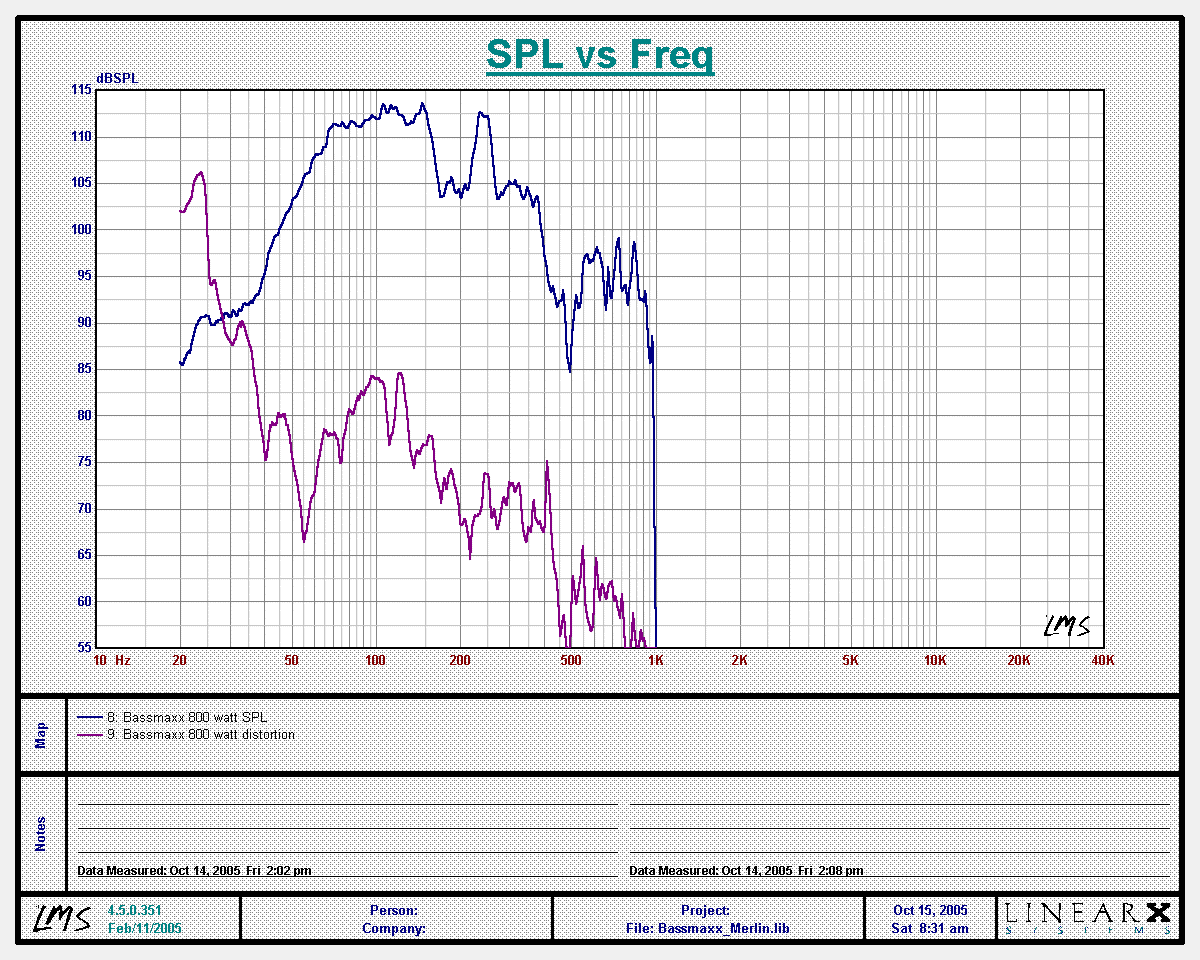
BassMaxx Deuce, 800 watts:
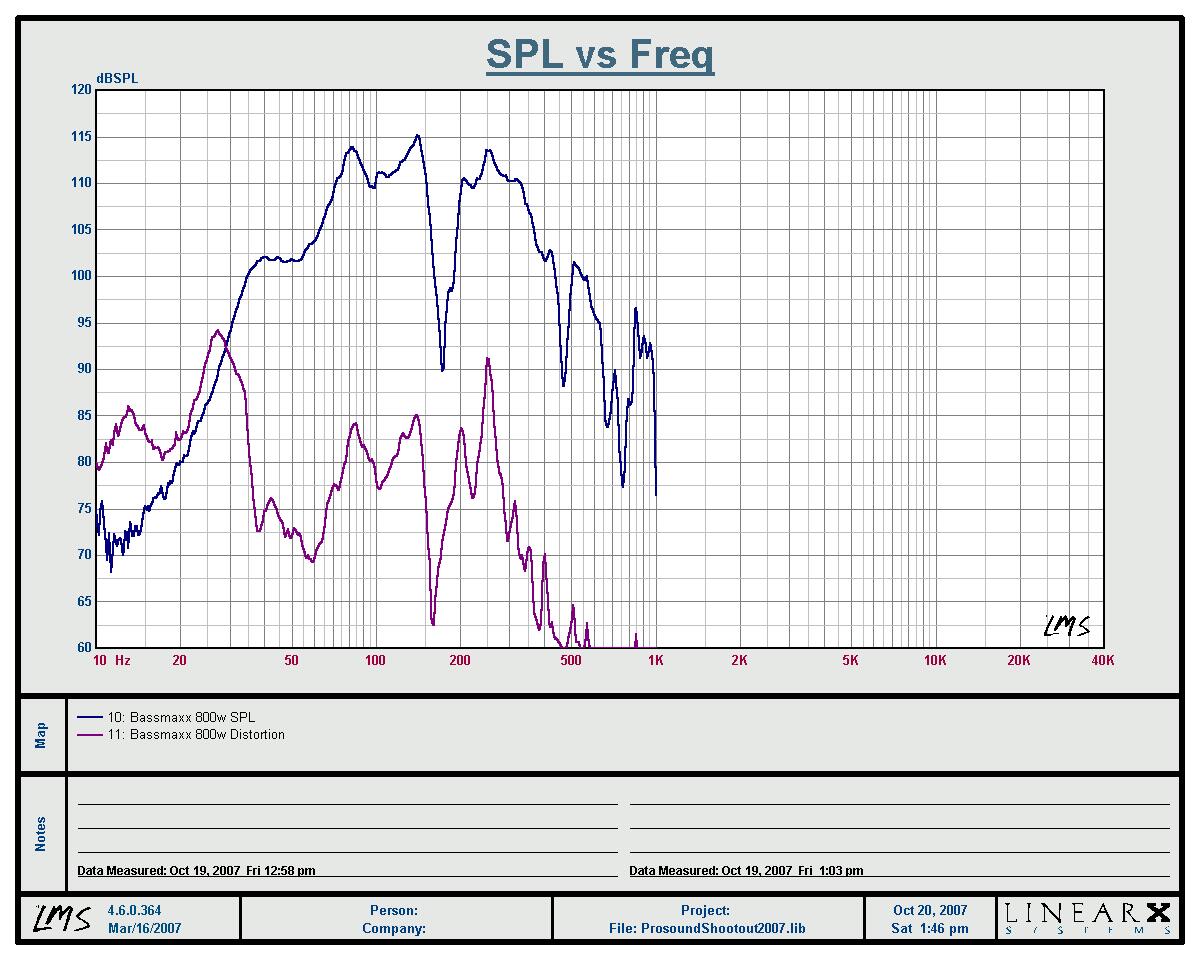
FitzmauriceTuba 24, 600 watts:
(Sweep started at 30Hz to prevent overexcursion)
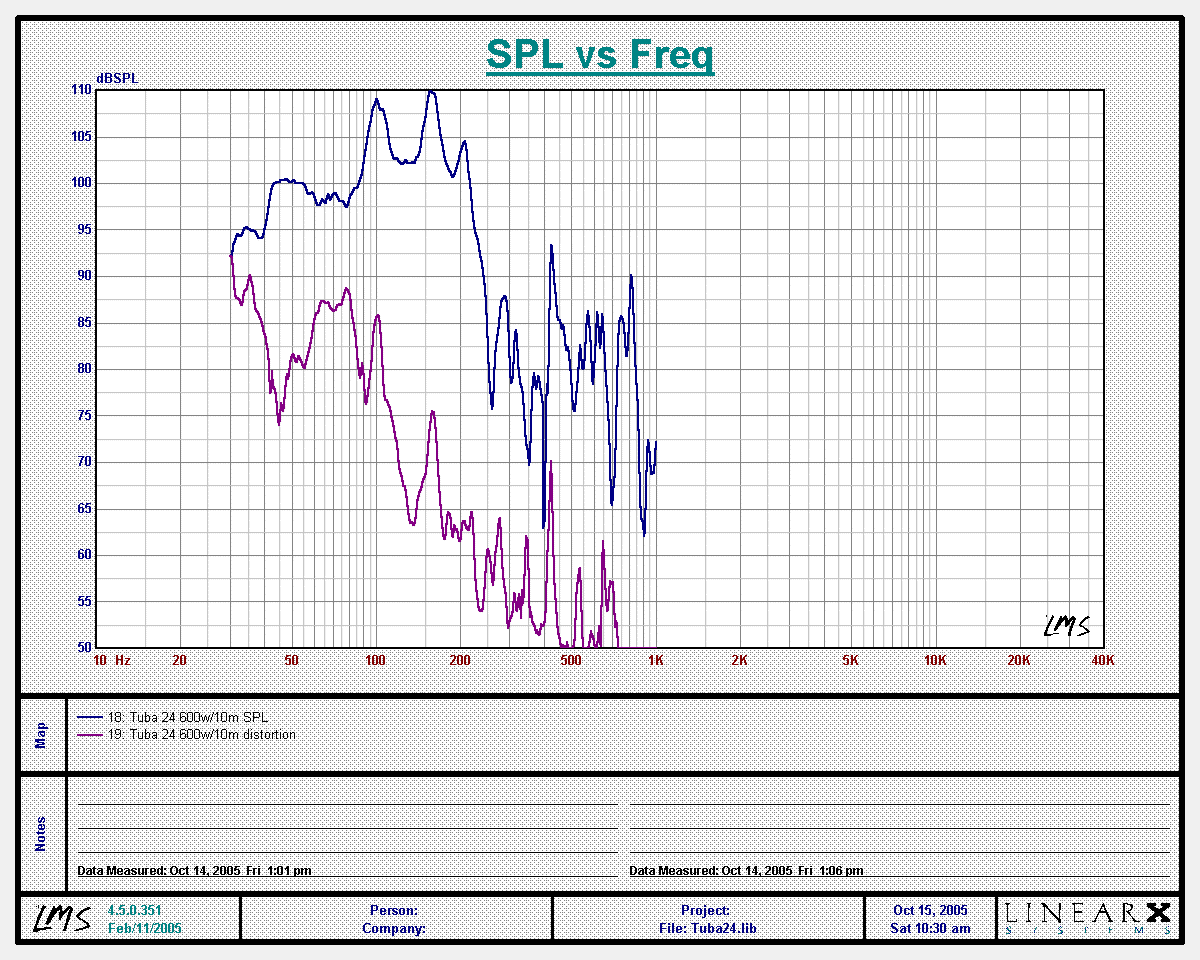
Fitzmaurice Titan 48, 800 watts:
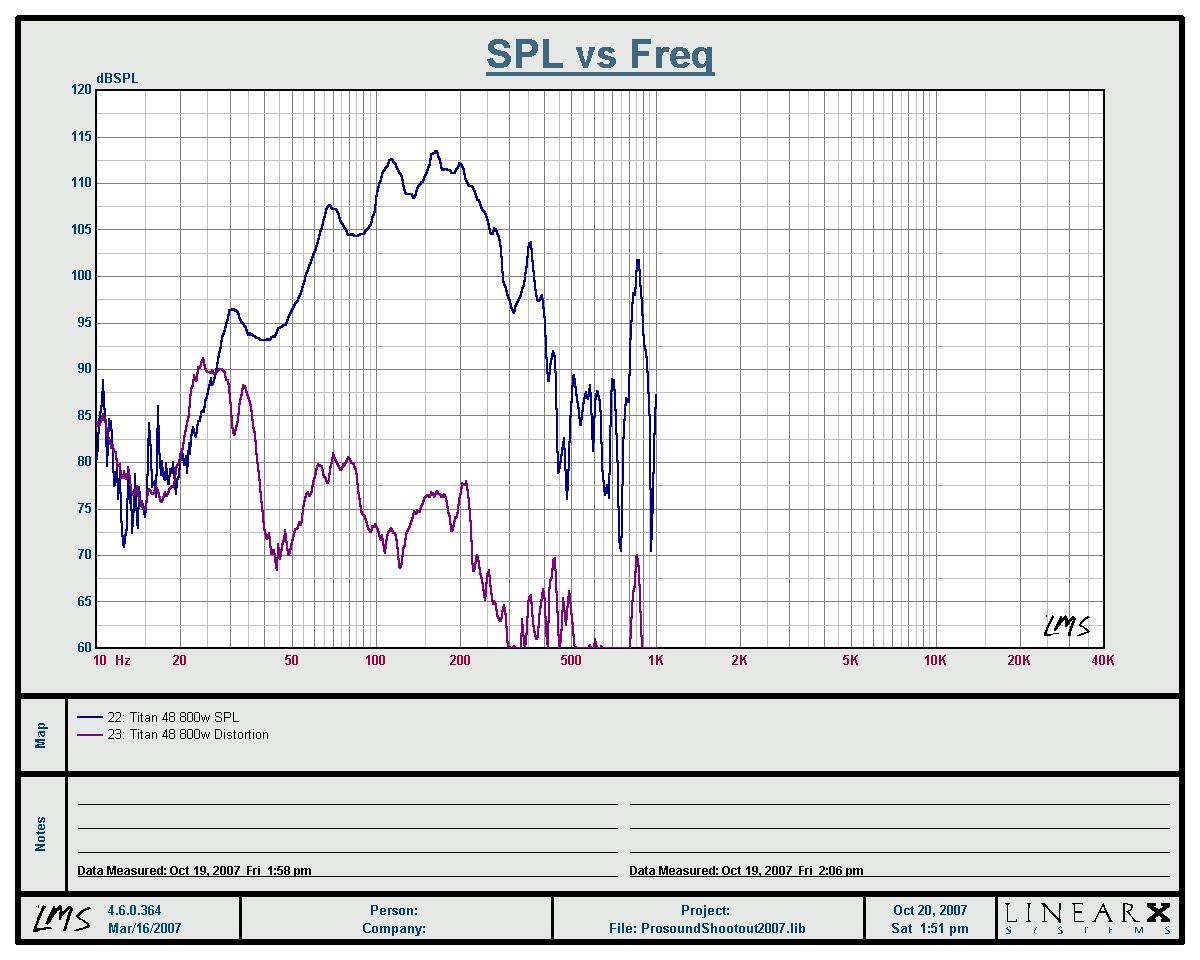
JTR Growler, 800 watts:
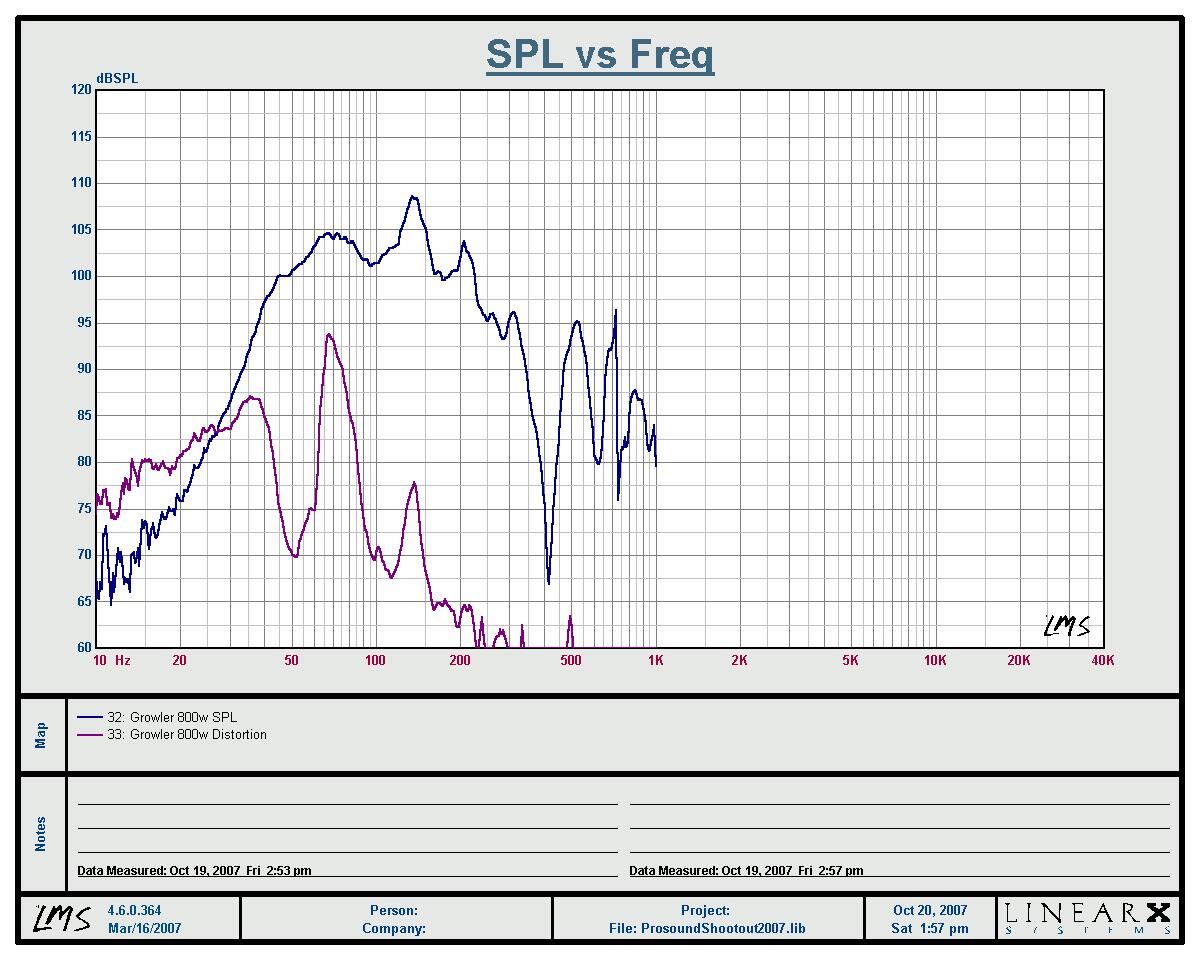
12Pi, 800 watts:
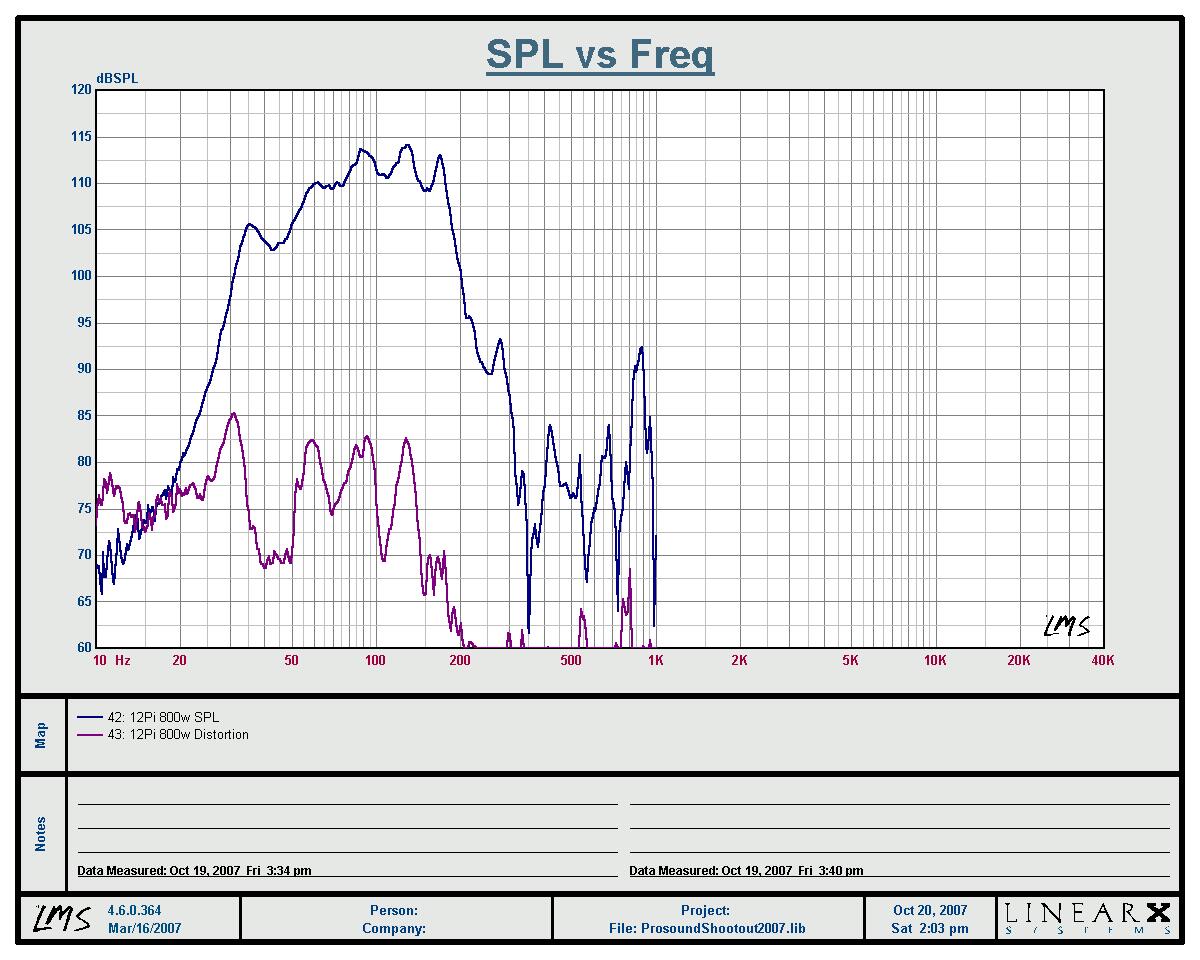
BassMaxx Z5, 1200 watts:
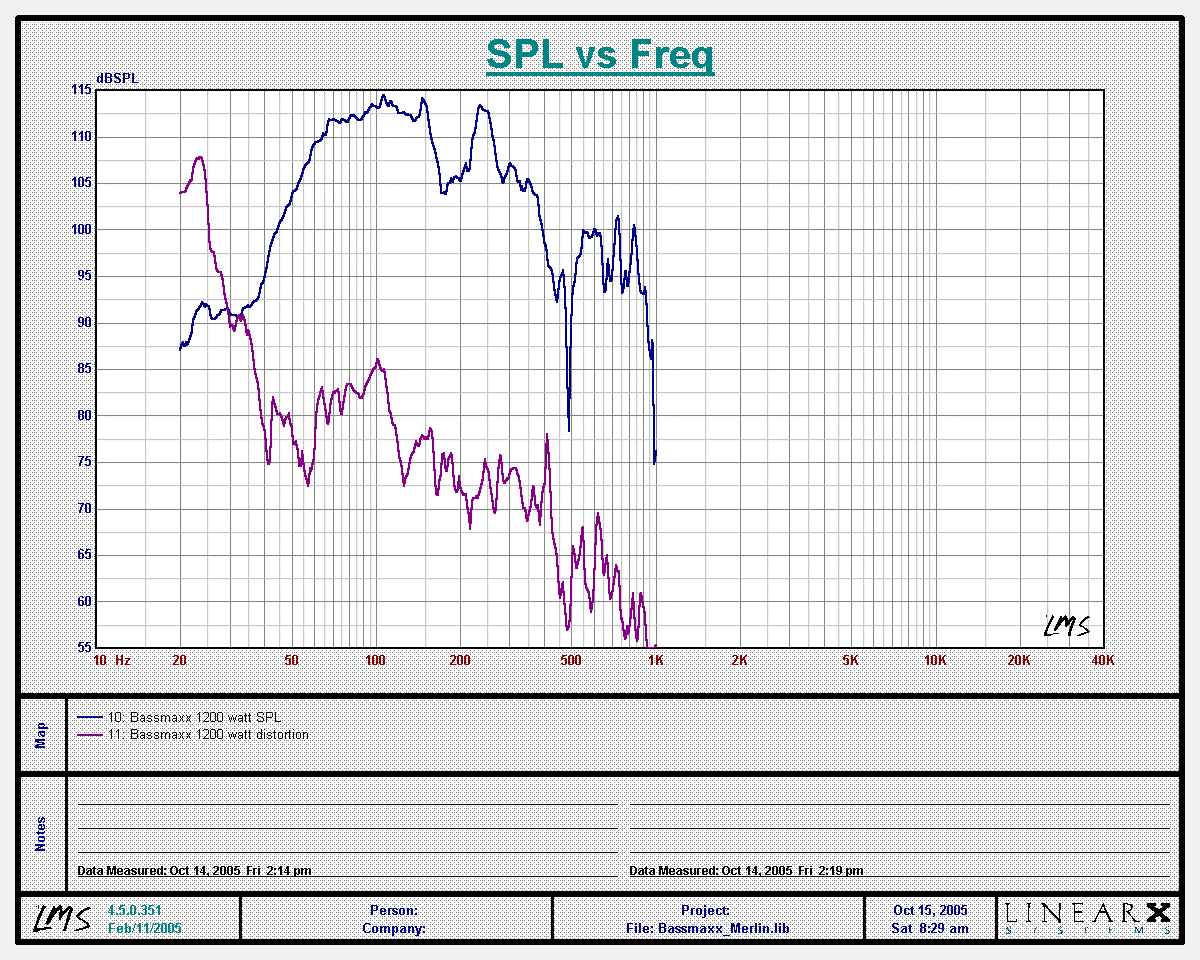
BassMaxx Deuce, 1600 watts:
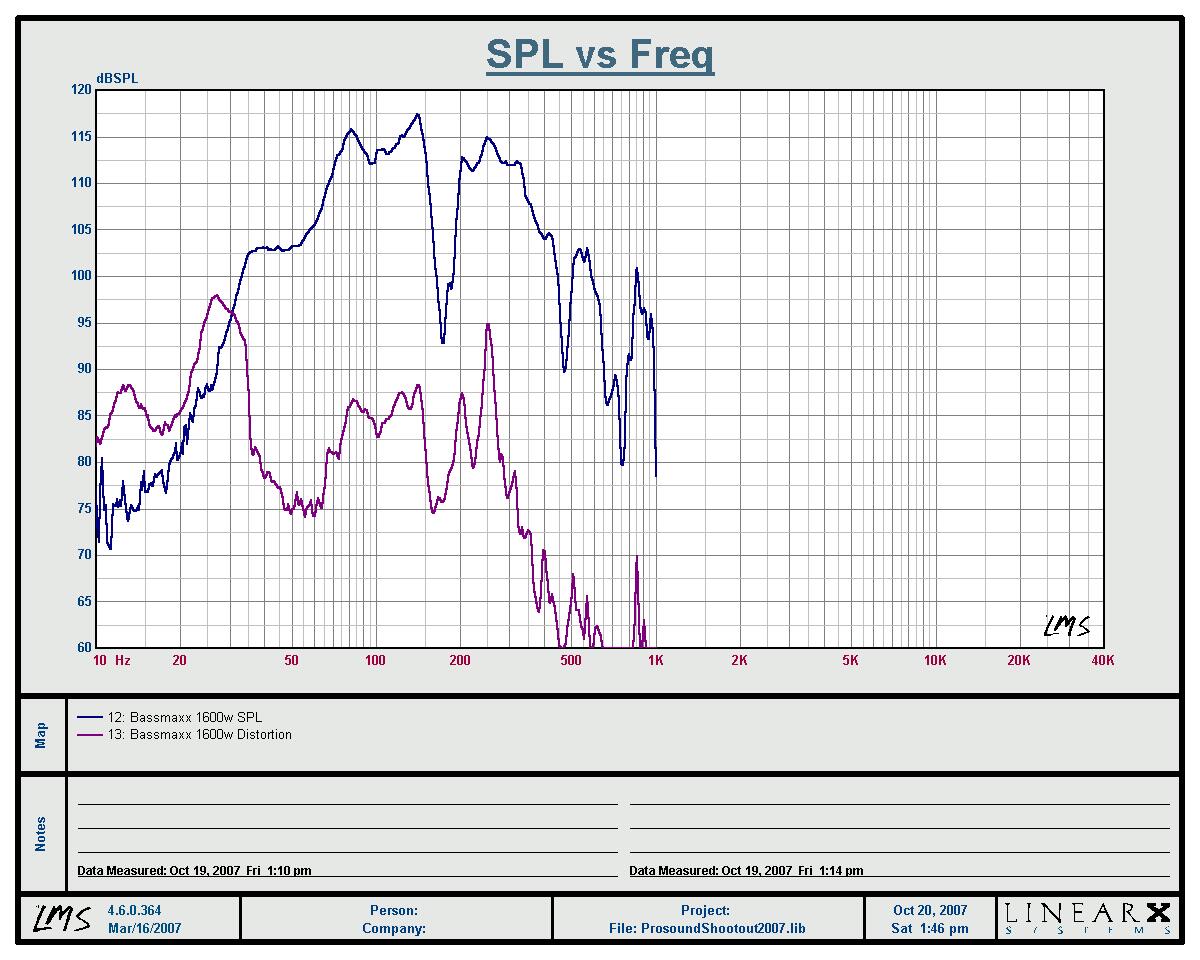
12Pi, 1600 watts:
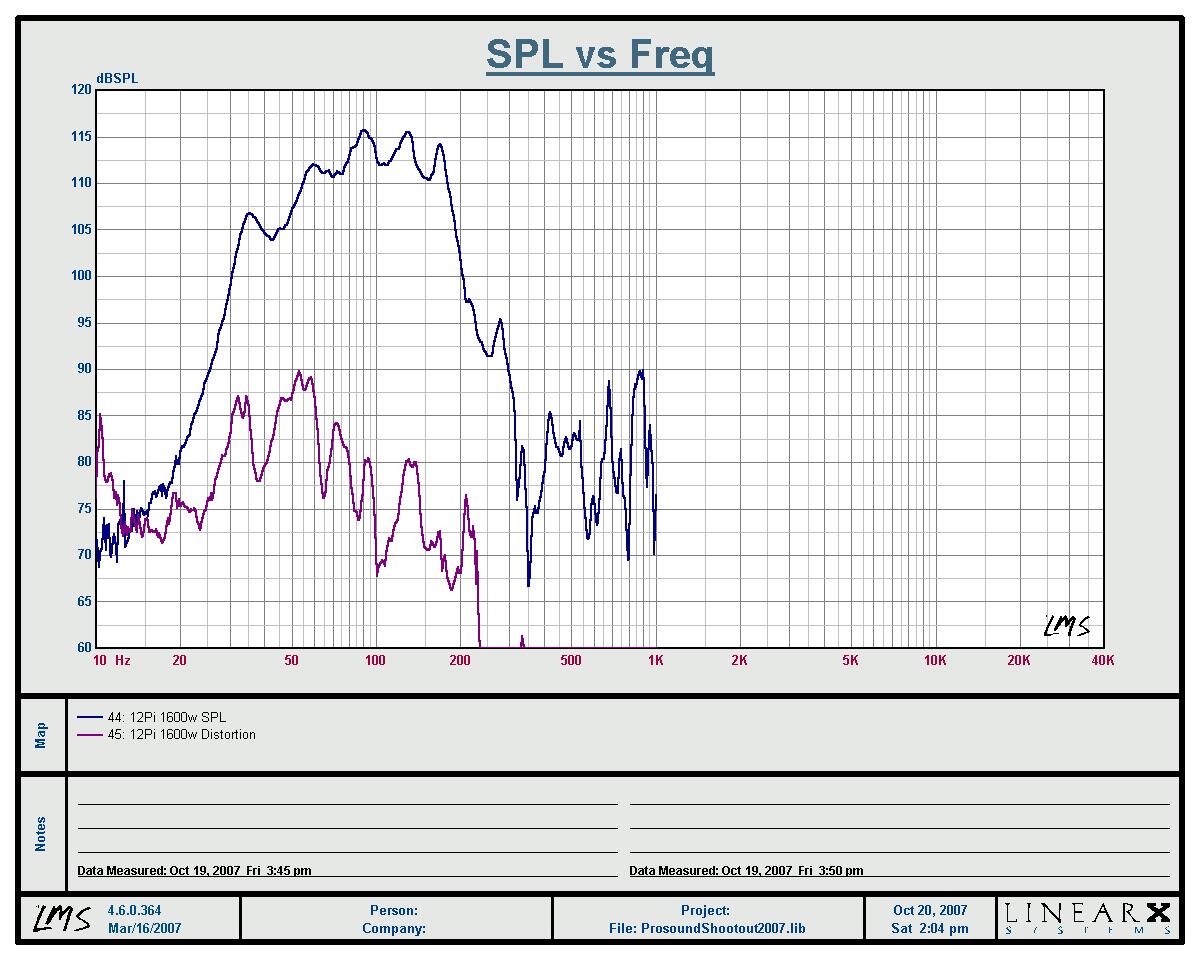
The evidence here is pretty convincing. If push-pull drive hadn't been used, distortion below cutoff would have been much higher at 20Hz. The cutoff frequency is 30Hz, so the drivers are unloaded below that. A traditional basshorn (without push-pull drive) has higher distortion below cutoff, and more importantly, through the passband.
This is what a LABhorn distortion curve looks like at 40 watts:
LABhorn, 40 watts: No, not 400 watts, just 40.
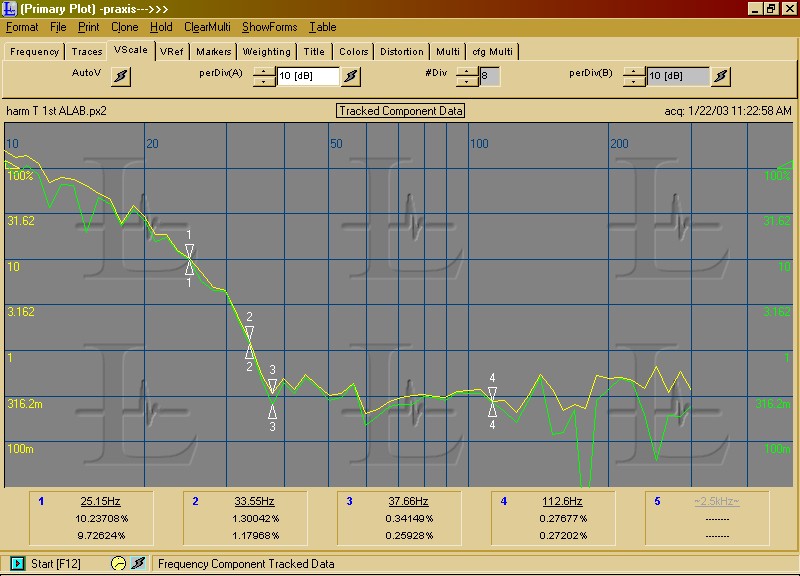
That's the kind of curve you expect to see for a horn or a reflex box. Below cutoff, the distortion rises real fast. That's why I wouldn't want to bump up the EQ down low for home theater. That will only make it worse.
The 12Pi hornsub distortion curve basically tracks the response curve. Where there's a slight rise in SPL, there's a slight rise in distortion. Down low, as the horn falls off at cutoff, the (distortion) harmonics fall off too. It just goes quiet.
This clearly shows that push-pull drive is very effective at reducing distortion. Probably why so many have gone to it for their top-of-the-line subwoofer systems.
But before I get started, I want to tell the readers here that most people don't question the validity of push-pull drive or cooling plugs. Do a search on the internet. Both are ideas that have been embraced from manufacturers seeking to improve performance.
In the five years or so since I introduced the 12Pi hornsub, I've noticed that even early naysayers have silently converted. Some initially questioned my use of push-pull drive, and attempted to minimize or criticize it, because, of course, they didn't use this technology and their distortion performance wasn't all that good. Now I'm seeing it in systems from these same people. Five years later, they've slipped it in. Their distortion has dropped, as a result. Good for them.
As an example, I now see it in a lot of tapped horn builds, some commercial, some DIY. That's a good application, I expect.
Look down through the charts in the link below. Pay special attention to the high-power sweeps, the ones at 800 watts and better. What you see is that every single speaker has pretty good distortion performance, except where you would expect - below cutoff. All have distortion that rises above the fundamental at the lowest frequencies. Not one has distortion lower in SPL than the fundamental at 20Hz, for example.
Except one. The one with Push-Pull Drive. The 12Pi hornsub.
I'll post the high-power charts here, for easy inspection:
BassMaxx Z5, 800 watts:

BassMaxx Deuce, 800 watts:

FitzmauriceTuba 24, 600 watts:
(Sweep started at 30Hz to prevent overexcursion)

Fitzmaurice Titan 48, 800 watts:

JTR Growler, 800 watts:

12Pi, 800 watts:

BassMaxx Z5, 1200 watts:

BassMaxx Deuce, 1600 watts:

12Pi, 1600 watts:

The evidence here is pretty convincing. If push-pull drive hadn't been used, distortion below cutoff would have been much higher at 20Hz. The cutoff frequency is 30Hz, so the drivers are unloaded below that. A traditional basshorn (without push-pull drive) has higher distortion below cutoff, and more importantly, through the passband.
This is what a LABhorn distortion curve looks like at 40 watts:
LABhorn, 40 watts: No, not 400 watts, just 40.

That's the kind of curve you expect to see for a horn or a reflex box. Below cutoff, the distortion rises real fast. That's why I wouldn't want to bump up the EQ down low for home theater. That will only make it worse.
The 12Pi hornsub distortion curve basically tracks the response curve. Where there's a slight rise in SPL, there's a slight rise in distortion. Down low, as the horn falls off at cutoff, the (distortion) harmonics fall off too. It just goes quiet.
This clearly shows that push-pull drive is very effective at reducing distortion. Probably why so many have gone to it for their top-of-the-line subwoofer systems.
Last edited:
im still struggling with how your push/pull works, exactly?
im used to seeing designs with 2 drivers clamped together cone to cone (with a spacer)
your design appears to have 2 drivers in completely separate/separated chambers/areas,
and although ive looked many times, i cant figure out how the output from one driver affects/influences the other?
im sure it does, i just cant 'see' it right now ?
im used to seeing designs with 2 drivers clamped together cone to cone (with a spacer)
your design appears to have 2 drivers in completely separate/separated chambers/areas,
and although ive looked many times, i cant figure out how the output from one driver affects/influences the other?
im sure it does, i just cant 'see' it right now ?
Last edited:
What you are describing is isobaric loading.
This is a push pull alignment with a sealed enclosure and more indicative of the method that Wayne is using.
This is a push pull alignment with a sealed enclosure and more indicative of the method that Wayne is using.
An externally hosted image should be here but it was not working when we last tested it.
i see a solid board between the 2 drivers ?
output from one driver goes around to the front of the other driver and increases resistance.
it seems to me?
edit: hang on, maybe im seeing it now?
.. yea ok, i got it
An externally hosted image should be here but it was not working when we last tested it.
An externally hosted image should be here but it was not working when we last tested it.
output from one driver goes around to the front of the other driver and increases resistance.
it seems to me?
edit: hang on, maybe im seeing it now?
.. yea ok, i got it
Last edited:
Isobaric is a whole different concept. Push-pull is exactly what it is and is NOT restricted to any type of enclosure. Next time read the text...What you are describing is isobaric loading.
This is a push pull alignment with a sealed enclosure and more indicative of the method that Wayne is using.
Thanks for the link, Djim. Good write-up there.
Here's another page with a few links:
Also, search Google. Lots of information there. Including several configurations that are sometimes called "push-pull" - learn the differnce. Each has its own strengths and weaknesses.
The illustration dneuma04 posted is a good picture of what I'm talking about. But I believe isobaric is something else. It's one of the other configurations.
An isobaric configuration has two cones driven so that the area between them maintains equal pressure. It is something like having the cones physically connected, for larger mass and stonger motor but without increasing radiating area. This effectively changes the electro-mechanical parameters of the new drive unit. Side note: There is a difference between isobaric and physically connecting two cones together. Air is compressible, so it is not fully connected. But close.
The push-pull arrangement I use has both drivers providing positive pressure (not isobaric). When one pressurizes the front chamber, so does the other. The idea is that the minor asymmetries of each will cancel the other, a matched pair.
Here's another page with a few links:
Also, search Google. Lots of information there. Including several configurations that are sometimes called "push-pull" - learn the differnce. Each has its own strengths and weaknesses.
The illustration dneuma04 posted is a good picture of what I'm talking about. But I believe isobaric is something else. It's one of the other configurations.
An isobaric configuration has two cones driven so that the area between them maintains equal pressure. It is something like having the cones physically connected, for larger mass and stonger motor but without increasing radiating area. This effectively changes the electro-mechanical parameters of the new drive unit. Side note: There is a difference between isobaric and physically connecting two cones together. Air is compressible, so it is not fully connected. But close.
The push-pull arrangement I use has both drivers providing positive pressure (not isobaric). When one pressurizes the front chamber, so does the other. The idea is that the minor asymmetries of each will cancel the other, a matched pair.
One other attribute you have not mentioned is the 12Pi uses separate compression chambers for each driver, which also contributes to lowering distortion.The push-pull arrangement I use has both drivers providing positive pressure (not isobaric). When one pressurizes the front chamber, so does the other. The idea is that the minor asymmetries of each will cancel the other, a matched pair.
Isobaric is a whole different concept. Push-pull is exactly what it is and is NOT restricted to any type of enclosure. Next time read the text...
I'm very well aware of the two concepts. I should have quoted the poster asking the question to make it clear who I was responding to. When I started the reply, you hadn't replied yet, I was distracted by family matters and by the time I finished, you posted. Next time, kindly keep your attitude to yourself.
FWIW, neither push-pull nor isobaric are restricted to any sort of enclosure type.
Last edited:
You are right, they are both not restricted to any sort of enclosure (thanks for the reply on my pm).FWIW, neither push-pull nor isobaric are restricted to any sort of enclosure type.
Thanks Wayne for the link but actually I read it already. The effectiveness of the push-pull can be broadened over a wider frequency range if you place them closer and symmetric together.Thanks for the link, Djim. Good write-up there.
Here's another page with a few links: Push-pull verses shorting rings
That would explain why Wayne is only measuring benefits in the lowest octave of his 12Pi.One other attribute you have not mentioned is the 12Pi uses separate compression chambers for each driver, which also contributes to lowering distortion.
The entrance from front chambers to throat are fairly close together, only 7.6" apart. Each front chamber and each rear chamber are the same size, in order to maintain a symmetrical air load.
I had thought about making the front chamber entry points even closer together, but there were other competing priorities, such as sizing the front and rear chambers, driver mounting, outboard cooling plugs, and doing it all in a way that came together sensibly for manufacturing and service. I actually have built three versions, the prototype, the first production version and the second production version. Only slight changes in each, but I think we got closer to the ideal each time. Kind of a juggling act, though really, it all fits together like a glove. In terms of wavelength, 7.6" is pretty tight spacing, and the front/rear chambers wrap around the drivers just right.
I had thought about making the front chamber entry points even closer together, but there were other competing priorities, such as sizing the front and rear chambers, driver mounting, outboard cooling plugs, and doing it all in a way that came together sensibly for manufacturing and service. I actually have built three versions, the prototype, the first production version and the second production version. Only slight changes in each, but I think we got closer to the ideal each time. Kind of a juggling act, though really, it all fits together like a glove. In terms of wavelength, 7.6" is pretty tight spacing, and the front/rear chambers wrap around the drivers just right.
With only 7.6" between the sound sources, the coupling between them is very good. Distortion reduction from push-pull drive works through the whole passband. In fact, distortion is actually lower at higher frequencies than it is down low.
The reason I sometimes point to the distortion at the lowest frequencies (below cutoff) is that's where it is most obvious. Distortion from a horn or reflex box run below cutoff quickly rises well over 100%. The harmonics generated are louder than the fundamental. In fact, that's all you can hear. When push-pull drive is used, this doesn't happen. The distortion products are cancelled, so signals presented below the cutoff frequency simply make no sound. It's prima facie evidence that the push-pull mechanism is working, and it is not subtle. The difference is huge.
Now then, most times, people won't run a reflex box or basshorn at high power levels below the passband. Perhaps some might, but that isn't really recommended. So the below-cutoff discussion is somewhat academic. What is more relevant, perhaps, is the fact that push-pull drive clearly works to reduce distortion.
Also relevant, is the fact that push-pull only cancels even-harmonics. The second harmonic is reduced, but third isn't. That's where the horn folds and the front chamber size (which acts as a low-pass filter) come into play.
Second harmonics from signals presented in the passband are from 60Hz and up. Those are cancelled by push-pull drive. Third harmonics (and higher) start at 90Hz (3x cutoff). This is very near the upper cutoff of the horn. The bandpass nature of the horn - the low-pass filter of the front chamber - reduces distortion of the third harmonic and all higher harmonics.
At 100 watts, the distortion is below the noise floor. We can't even see it. It is less than 1% through the passband.
12Pi hornsub, 100 watts:
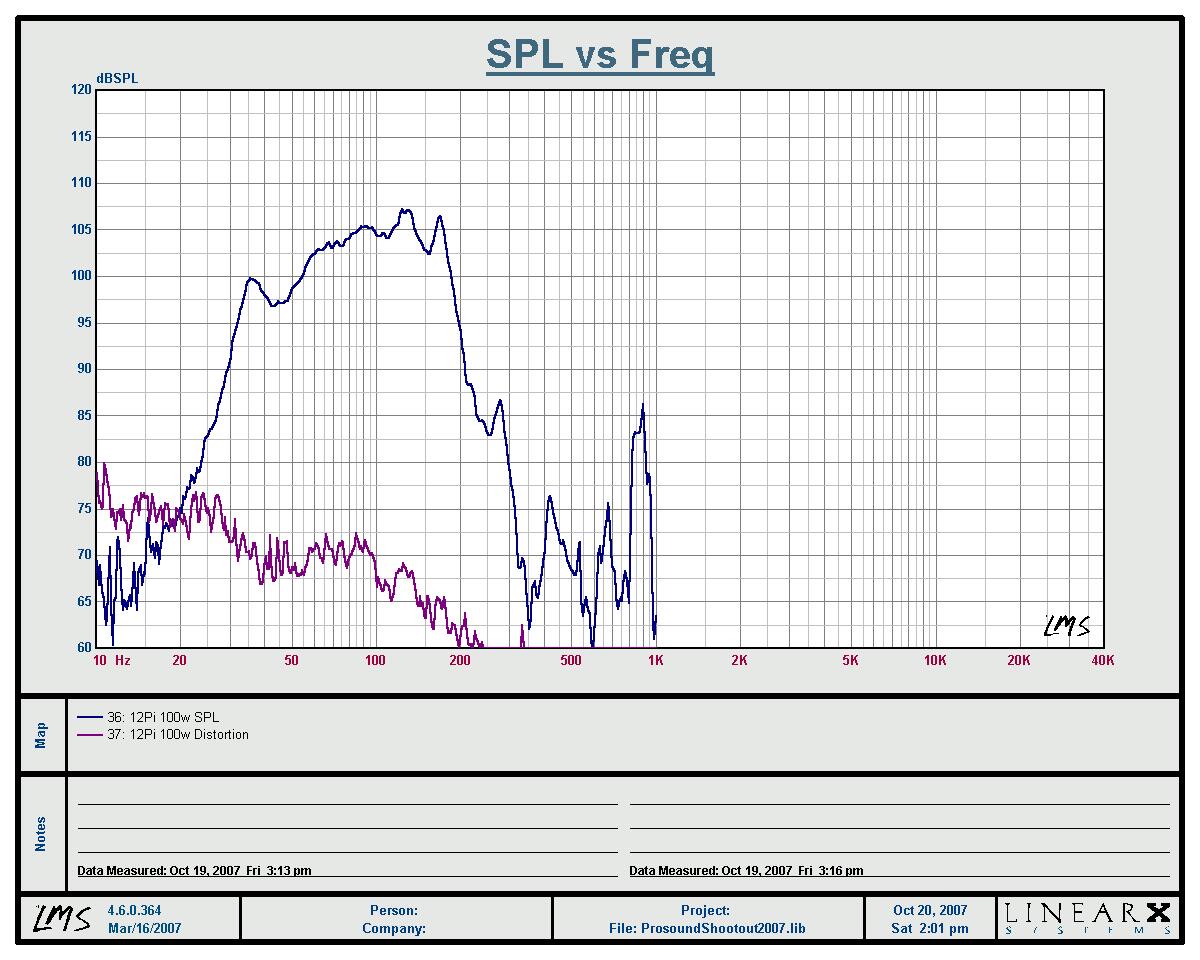
By 200 watts, it becomes visible, and ranges between -40dB and -30dB (1% to 3%) through most of the the passband. It stays fairly constant at this level all the way up to 800 watts. Generally, distortion is lower at high frequencies than low frequencies, a combination of several factors, including the naturally lower excursion at high frequencies and the low-pass from the front chamber as well as the effects of push-pull drive.
12Pi hornsub, 200 watts:
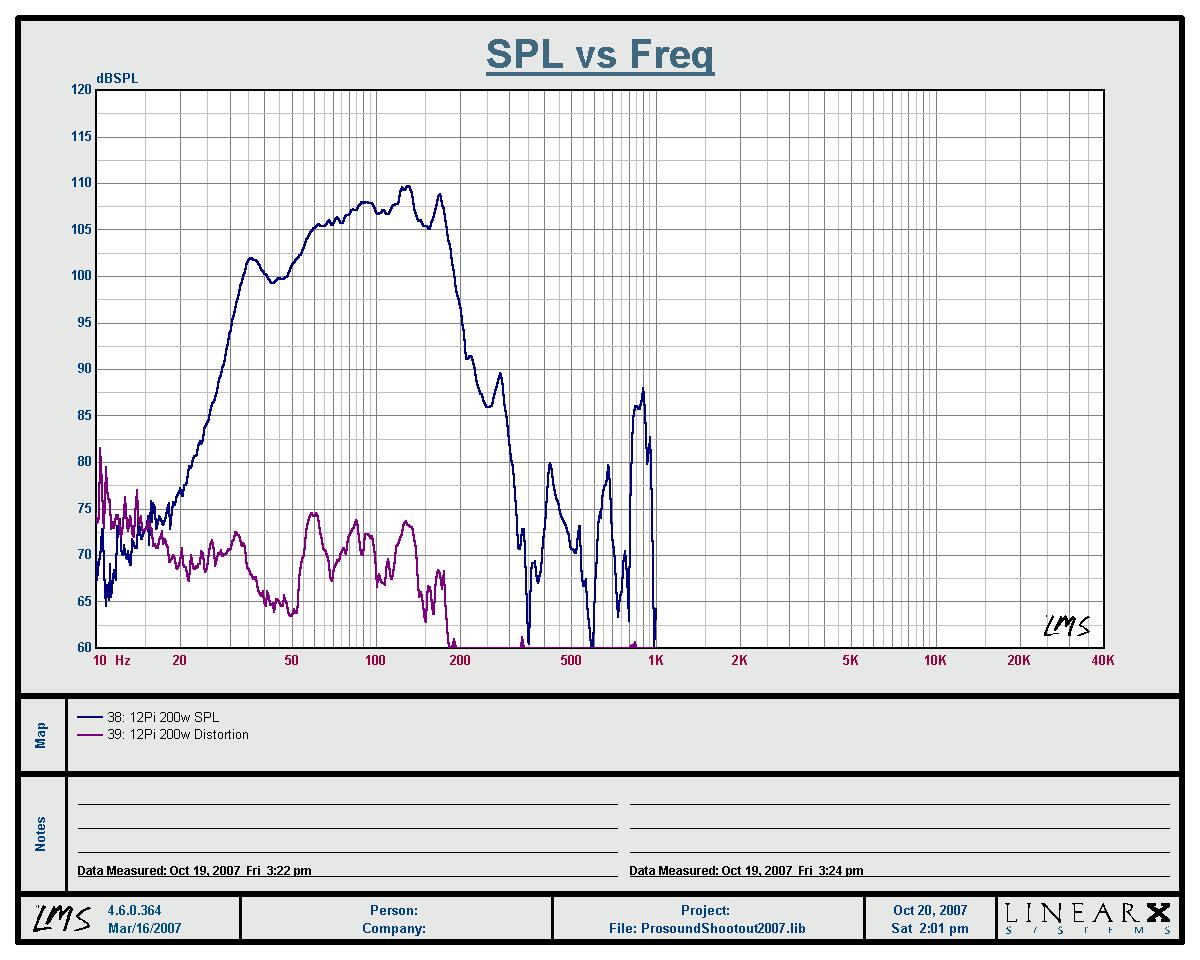
12Pi hornsub, 400 watts:
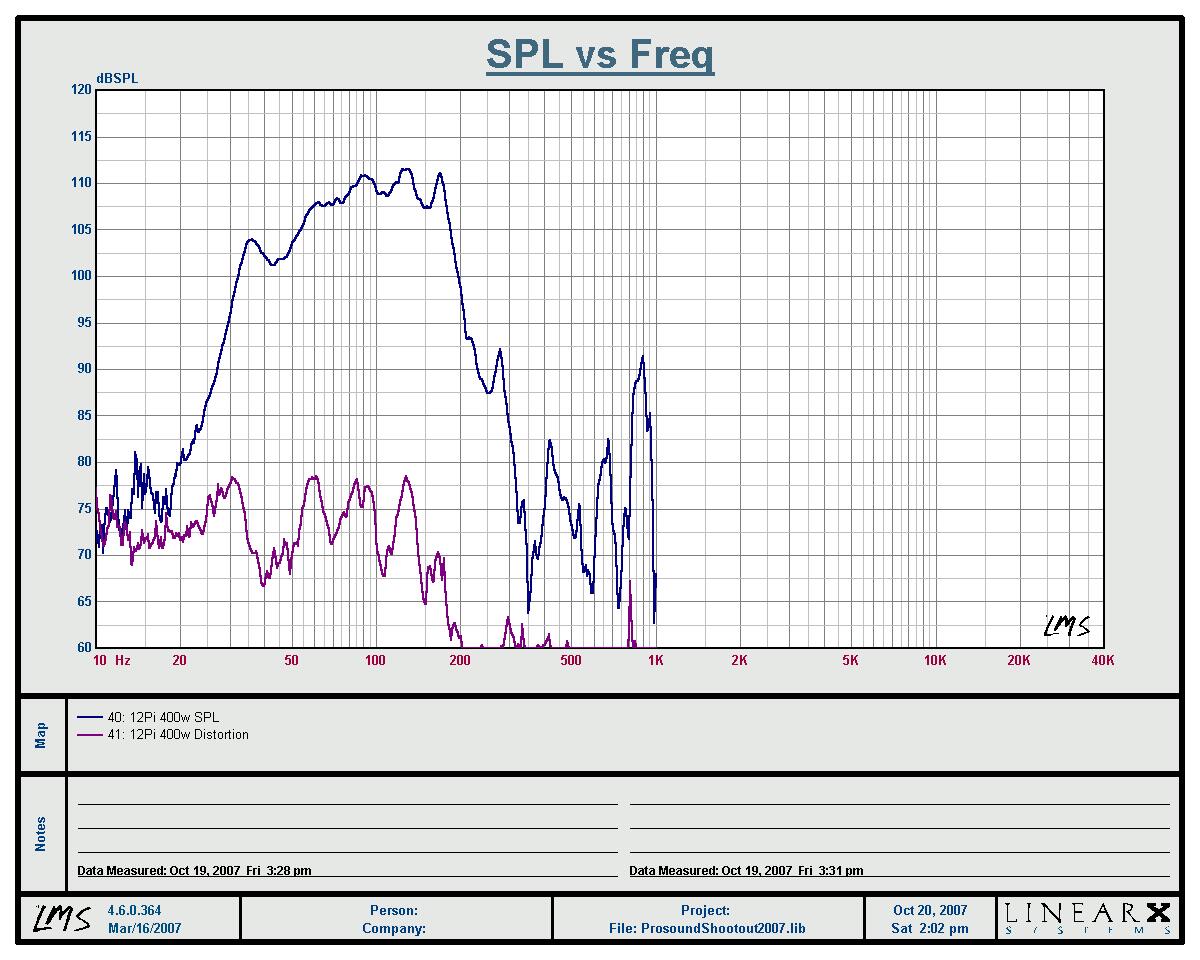
12Pi hornsub, 800 watts:

By 1600 watts, it has risen slightly at the low end of the passband, to -25dB or so (5%) at the highest peaks. However, this is when the hornsub is "on the cooling pipe". It will operate at this power level, and could actually be used there continuously. But as with any loudspeaker, you want that top 3dB (at least) to be headroom. Also note that even at this high level, the distortion at the upper end of the passband is still in the -30dB to -40dB (1% to 3%) range. Again, this is because we have all three factors working for us, push-pull drive, low-pass from front chamber size and reduced excursion. At this high power level, excursion is definitely high - but as a function of frequency, it's lower compared to the excurion at the low end of the passband.
12Pi hornsub, 1600 watts:

One final word on distortion measurements. The plots above are stepped sine measurements with several hundred steps taken through the sweep. This is the best way to plot distortion, in my opinion. You can plot them as individual harmonics or as THD, or both. But if you don't have a chart that shows a continuous plot, i.e. several data points at tightly spaced frequencies, you miss a lot of detail. This is especially true for horns. With fewer data points, say using 10Hz increments, you can be off by as much as 10dB, several percent. The difference between -25dB and -15dB is 10%.
For example, say measurements are only taken approximately every 10Hz. Look up at the charts, see that the distortion peaks and dips, often by as much as 10dB - 15dB in a fairly narrow frequency span. It is easy to pick frequency values where distortion is low, missing the 15dB jumps in between.
When examining distortion charts that are measured with less than 1Hz increments, it is difficult to compare with charts measured with 10Hz increments. You can't know if each 10Hz increment represents a high-distortion spot or a low-distortion one. This is an important difference, and is why single figure distortion values (or those taken with very few samples, like 10Hz) are not particularly useful, in my opinion. They just miss too much.
The reason I sometimes point to the distortion at the lowest frequencies (below cutoff) is that's where it is most obvious. Distortion from a horn or reflex box run below cutoff quickly rises well over 100%. The harmonics generated are louder than the fundamental. In fact, that's all you can hear. When push-pull drive is used, this doesn't happen. The distortion products are cancelled, so signals presented below the cutoff frequency simply make no sound. It's prima facie evidence that the push-pull mechanism is working, and it is not subtle. The difference is huge.
Now then, most times, people won't run a reflex box or basshorn at high power levels below the passband. Perhaps some might, but that isn't really recommended. So the below-cutoff discussion is somewhat academic. What is more relevant, perhaps, is the fact that push-pull drive clearly works to reduce distortion.
Also relevant, is the fact that push-pull only cancels even-harmonics. The second harmonic is reduced, but third isn't. That's where the horn folds and the front chamber size (which acts as a low-pass filter) come into play.
Second harmonics from signals presented in the passband are from 60Hz and up. Those are cancelled by push-pull drive. Third harmonics (and higher) start at 90Hz (3x cutoff). This is very near the upper cutoff of the horn. The bandpass nature of the horn - the low-pass filter of the front chamber - reduces distortion of the third harmonic and all higher harmonics.
At 100 watts, the distortion is below the noise floor. We can't even see it. It is less than 1% through the passband.
12Pi hornsub, 100 watts:

By 200 watts, it becomes visible, and ranges between -40dB and -30dB (1% to 3%) through most of the the passband. It stays fairly constant at this level all the way up to 800 watts. Generally, distortion is lower at high frequencies than low frequencies, a combination of several factors, including the naturally lower excursion at high frequencies and the low-pass from the front chamber as well as the effects of push-pull drive.
12Pi hornsub, 200 watts:

12Pi hornsub, 400 watts:

12Pi hornsub, 800 watts:

By 1600 watts, it has risen slightly at the low end of the passband, to -25dB or so (5%) at the highest peaks. However, this is when the hornsub is "on the cooling pipe". It will operate at this power level, and could actually be used there continuously. But as with any loudspeaker, you want that top 3dB (at least) to be headroom. Also note that even at this high level, the distortion at the upper end of the passband is still in the -30dB to -40dB (1% to 3%) range. Again, this is because we have all three factors working for us, push-pull drive, low-pass from front chamber size and reduced excursion. At this high power level, excursion is definitely high - but as a function of frequency, it's lower compared to the excurion at the low end of the passband.
12Pi hornsub, 1600 watts:

One final word on distortion measurements. The plots above are stepped sine measurements with several hundred steps taken through the sweep. This is the best way to plot distortion, in my opinion. You can plot them as individual harmonics or as THD, or both. But if you don't have a chart that shows a continuous plot, i.e. several data points at tightly spaced frequencies, you miss a lot of detail. This is especially true for horns. With fewer data points, say using 10Hz increments, you can be off by as much as 10dB, several percent. The difference between -25dB and -15dB is 10%.
For example, say measurements are only taken approximately every 10Hz. Look up at the charts, see that the distortion peaks and dips, often by as much as 10dB - 15dB in a fairly narrow frequency span. It is easy to pick frequency values where distortion is low, missing the 15dB jumps in between.
When examining distortion charts that are measured with less than 1Hz increments, it is difficult to compare with charts measured with 10Hz increments. You can't know if each 10Hz increment represents a high-distortion spot or a low-distortion one. This is an important difference, and is why single figure distortion values (or those taken with very few samples, like 10Hz) are not particularly useful, in my opinion. They just miss too much.
Last edited:
Wayne,When examining distortion charts that are measured with less than 1Hz increments, it is difficult to compare with charts measured with 10Hz increments. You can't know if each 10Hz increment represents a high-distortion spot or a low-distortion one. This is an important difference, and is why single figure distortion values (or those taken with very few samples, like 10Hz) are not particularly useful, in my opinion. They just miss too much.
I would agree that 10 Hz intervals at low frequencies (around Fc or Fb) are too wide to give the detail needed for close comparisons, which is why I used 5 Hz increments down low, and 10 Hz up higher, where excursion related distortion generally "settles down", tapped horns being an exception to that rule.
While I agree that the more data points the better, I disagree that data presented using the same 5 Hz increments for multiple speakers under test is not useful, distortion trends are quite visible.
For instance, it is obvious from my testing using 5 Hz intervals that the 12Pi has less distortion at full power than anything I tested.
It is also obvious that certain manufacturers that claim "high fidelity" obviously figured no one would bother checking their speakers for distortion when used within the rated frequency response at the rated power levels. My tests ruffled their feathers, and resulted in various "explanations" that simply don't hold up.
Also obvious is that at -10 dB in frequency response below Fb or Fc, distortion rises to objectionable levels well below full power in every speaker tested, for full power use if distortion is a concern, the -3 dB point is as low as should be considered useful, and with the way some manufactures rate the -3 dB point, "useful" high power response that low may be stretching things.
And also obvious is buyers vote with their checkbooks, the cabinets purchased in general prove that distortion seldom enters the purchase decision..
Art Welter
I agree with you. Trending is relevant, and it is never a bad thing to have more information, more visibility. I would rather have a list of values at 10Hz increments than a single value with no frequency listed.
Please understand the paragraph you quoted me on, I said, "When examining distortion charts that are measured with less than 1Hz increments, it is difficult to compare with charts measured with 10Hz increments. You can't know if each 10Hz increment represents a high-distortion spot or a low-distortion one. This is an important difference, and is why single figure distortion values (or those taken with very few samples, like 10Hz) are not particularly useful, in my opinion."
My point is that if you have a chart with stepped sines, each step being 0.1Hz apart and you compare with a list of values 10Hz apart, it is easy to misinterpret the data. There are a lot of "jaggies" in there that could be missed, or worse, misconstrued.
I also agree with you that if you measure the distortion of a vented box or horn below cutoff, where it is -10dB down in amplitude, distortion will be very high. I think that's what you are saying, yes? If so, we're in agreement.
How then, I am wondering, did we come to any disagreement? I could have sworn you said a few days ago that you measured distortion of a vented box at full power, like ~20% below the frequency frequency, and found it to be low, like 5% or something. That was one of the things that didn't seem to pass the "sniff test" to me. Did I misinterpret your comments?
Please understand the paragraph you quoted me on, I said, "When examining distortion charts that are measured with less than 1Hz increments, it is difficult to compare with charts measured with 10Hz increments. You can't know if each 10Hz increment represents a high-distortion spot or a low-distortion one. This is an important difference, and is why single figure distortion values (or those taken with very few samples, like 10Hz) are not particularly useful, in my opinion."
My point is that if you have a chart with stepped sines, each step being 0.1Hz apart and you compare with a list of values 10Hz apart, it is easy to misinterpret the data. There are a lot of "jaggies" in there that could be missed, or worse, misconstrued.
I also agree with you that if you measure the distortion of a vented box or horn below cutoff, where it is -10dB down in amplitude, distortion will be very high. I think that's what you are saying, yes? If so, we're in agreement.
How then, I am wondering, did we come to any disagreement? I could have sworn you said a few days ago that you measured distortion of a vented box at full power, like ~20% below the frequency frequency, and found it to be low, like 5% or something. That was one of the things that didn't seem to pass the "sniff test" to me. Did I misinterpret your comments?
Typo - The last paragraph should read:
"How then, I am wondering, did we come to any disagreement? I could have sworn you said a few days ago that you measured distortion of a vented box at full power, like ~20% below the cutoff frequency, and found it to be low, like 5% or something. That was one of the things that didn't seem to pass the "sniff test" to me. Did I misinterpret your comments?"
"How then, I am wondering, did we come to any disagreement? I could have sworn you said a few days ago that you measured distortion of a vented box at full power, like ~20% below the cutoff frequency, and found it to be low, like 5% or something. That was one of the things that didn't seem to pass the "sniff test" to me. Did I misinterpret your comments?"
7.6” (193mm) is indeed "fairly" close. I didn't realise the short distance because of the cooling plugs in the side walls. Using Push-Pull in (tapped) horns usually ends in a choice of which side you want the drivers being coupled to the same air.The entrance from front chambers to throat are fairly close together, only 7.6" apart. I had thought about making the front chamber entry points even closer together, but there were other competing priorities
The disagreement seems to have come when I pointed out that a standard ported alignment using Lab 12s happened to have less distortion with 49 volts sine wave at 30 Hz (9 % compared to 28%) than the 12Pi.Typo - The last paragraph should read:
"How then, I am wondering, did we come to any disagreement? I could have sworn you said a few days ago that you measured distortion of a vented box at full power, like ~20% below the cutoff frequency, and found it to be low, like 5% or something. That was one of the things that didn't seem to pass the "sniff test" to me. Did I misinterpret your comments?"
I have no disagreement that where it counts, in the passband, the 12Pi has less distortion, as my post # 96 shows.
http://www.diyaudio.com/forums/subwoofers/190832-bill-fitzmaurice-designs-question-15.html
I did not do distortion tests with my ported Lab 12s below 30 Hz, so don’t know at what frequency the distortion would rise above 100% at 49 volts, but I doubt it would be as low as the 12Pi, as the small compression chambers of the 12Pi would limit excursion more than the much larger (unloaded) ported box.
If the distortion figures below Fc on the LABhorn you previously posted are correct (and the cabinet was properly built and had no air leaks, etc.) then it is obvious that the 12Pi distortion is much lower below Fc.
The compression chamber to front chamber relationship is different in the 12Pi compared to the LABhorn, that may actually be the primary contributor to the lowering of distortion.
Although I have no doubt that push pull may reduce distortion, without trying your design “normal” compared to push pull, there is no data to tell what percentage the push pull contributes to the reduction.
Although I would not put much money on a bet, probably not enough to even cover your time for the experiment if I lost, my bet would be the difference in distortion below 30 Hz with the Pi12 “normal” (as opposed to push pull), but with speaker magnets both towards the horn throat chamber, would result in less than a 10% difference in distortion below Fc, and 2% above.
Art Welter
Look carefully at the cooling plug data and discussions. You'll see that my first cooling system experiments used air ducting, in an effort to ensure that the heated rear chamber air wasn't passing through the vents. What I found was this almost didn't matter at all. You can refrigerate the air in the vicinity of the vent and the core heating still becomes a problem at high power levels. In fact, one of the LAB12 destructive tests was with an exposed magnet, surrounded by cool air at all times.
About the vented box distortion, I seem to recall you said the Helmholtz frequency was 36Hz. Excursion (and distortion) doesn't rise immediately at cutoff, but it does rise pretty fast below it. If it was tuned for 36Hz, I would expect distortion to be high at 30Hz, because that's like 20% below resonance. I wonder if maybe the Helmholtz frequency is actually lower than 36Hz? I just can't see distortion being as low as the passband level, 20% below cutoff.
About the vented box distortion, I seem to recall you said the Helmholtz frequency was 36Hz. Excursion (and distortion) doesn't rise immediately at cutoff, but it does rise pretty fast below it. If it was tuned for 36Hz, I would expect distortion to be high at 30Hz, because that's like 20% below resonance. I wonder if maybe the Helmholtz frequency is actually lower than 36Hz? I just can't see distortion being as low as the passband level, 20% below cutoff.
- Status
- This old topic is closed. If you want to reopen this topic, contact a moderator using the "Report Post" button.
- Home
- Loudspeakers
- Subwoofers
- Wayne's 12Pi sub